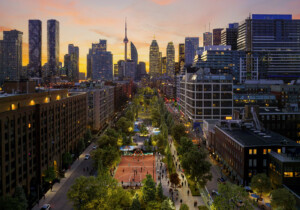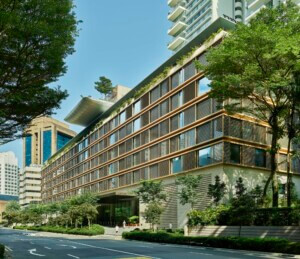Architect: Reimagine Architects
Location: Smoky Lake, Alberta, Canada
Completion Date: 2022
The Lodge is the latest addition to Metís Crossing, a hub for Indigenous tourism located outside of Edmonton, Alberta. Clad in Accoya wood and supported by exposed glulam columns and beams, the exterior detailing of the 40 key hotel recalls extant fur trading outposts and cabins located on the site.

Situated along the North Saskatchewan River, Metís Crossing is sited on the grounds of a historic Metís settlement. Originally incorporated to facilitate the fur trade, the settlement was organized as a river lot system—plots were subdivided in rectangular sections which extend from the river front.
Eventually the land was sold to a family of German farmers. The area was then reacquired by the Metís Nation of Alberta in the early 2000s. Shortly after, development began for Metís Crossing and Reimagine Architects were brought on to create a master plan.

There has been a rise in Indigenous culture–oriented tourism in conjunction with Canada’s national reconciliation initiatives, that began in earnest with the creation of the Truth and Reconciliation commission in 2015. Metís Crossing was conceived as one such example, offering cultural and culinary programming which showcase local customs.
Tiffany Shaw, Indigenous practice leader at Reimagine Architects and a member of Alberta’s Metís Nation, told AN, “In Canada we have a lot of forts where you can learn about trading history. But this is from a colonizer perspective. At Metís Crossing you can go and learn about the historic village—learn how people lived from an authentic point of view and in less of a narrative-driven way. You also learn about how we still live today and thrive—we are not dead.”

In addition to The Lodge, Reimagine Architects was responsible for the design of The Gathering Center, a community facility directly adjacent to the hotel. The building, completed in 2019, features a similar use of Accoya screens and timber detailing.

Accoya wood was chosen as the exterior cladding, as opposed to raw wood, to manage cost and reduce maintenance. Accoya is a proprietary wood product made from acetylated pine. It is stronger and more water resistant than untreated wood. Like other types of timber, the Accoya is expected to gray over time.
Vertical planks of the material separate each of The Lodge’s component units and double as sun screens. Solar heat gain on the interior was further reduced through the use of triple-glazed fiber glass windows.

In contrast to the darker wood tones of the exterior, the building’s interior prominently features white-colored wood. According to Shaw, this shade of lumber is more appropriate to Alberta, which is dominated by Aspen and Poplar trees.
“If I was in [British Columbia] I would use Redwood… Whereas here we were trying to use whitewood.”
The building’s glulam ceilings and columns were left exposed and manufactured using a mixture of spruce, pine, and fir species to achieve the paler hue.


Reimagine Architect’s design of The Lodge as well as the other structures at Metís Crossing, successfully integrates traditional Metís building practices with modern construction methods and contemporary materials. The project was also the result of a highly collaborative relationship between client and architect—one that goes back more than 20 years.
Shaw described how the Metís Crossing project and Reimagine Architect’s practice in general differs from the public’s notion of an architect’s role in construction. “Our Projects are built with community engagement from the beginning so that [client and architect] ideas are meshed together rather than the architect leading the process.”
Project Specifications
-
- Architect: Reimagine Architect
- Landscape Architect: Kafka Landscapes
- Interior Design: Reimagine Architects
- Structural Engineer: RJC, Remedy Engineering
- Electrical Engineer: Reimagine Consulting
- Civil Engineer: V3 Companies of Canada
- AV/Acoustics: Evolution AV
- Signage/Wayfinding: Modulex Alberta
- General Contractor: GenMec ACL
- Client: Metís Crossing
- Glazing Contractor: GlasCurtain
- Facade Installer: GenMec ACL
- Wood: Western Archrib, GenMec ACL
- Glass: GlasCurtain
- Windows: Glass8 Group of Companies
- Doors: ThermaTru Doors
- Roofing: Westman Steel











